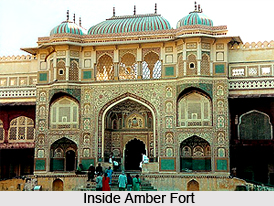 Jaipur which is also referred to as the Pink City is noted for its architectural wonder. The architecture of this capital city of Rajasthan is a beautiful fusion of yesteryears and modern architectural pattern. This city, with its well planned roads, can be compared with recently designed cities. It has earned the name Pink City, because most of the buildings have been painted pink. The main architectural creations of Jaipur are the amber fort palace, the City palace, the Jantar Mantar and the Hawa Mahal. The city is a square, eight hundred meters on each side and is divided into nine parts. The palace is located in the central, along with the unique Jantar Mantar.
Jaipur which is also referred to as the Pink City is noted for its architectural wonder. The architecture of this capital city of Rajasthan is a beautiful fusion of yesteryears and modern architectural pattern. This city, with its well planned roads, can be compared with recently designed cities. It has earned the name Pink City, because most of the buildings have been painted pink. The main architectural creations of Jaipur are the amber fort palace, the City palace, the Jantar Mantar and the Hawa Mahal. The city is a square, eight hundred meters on each side and is divided into nine parts. The palace is located in the central, along with the unique Jantar Mantar.
The capital city of Rajasthan was founded by Maharaja Sawai Jai Singh II of Amber in the year 1727. The very structure of Jaipur resembles the taste of the Rajputs and the Royal families. The King consulted several books on architecture and architects before making the lay out of Jaipur. The city was constructed following the principles of Shilpa Shastra, the Indian Architecture. The city witnessed a rapid growth in the 19th century. The architectural plan of Jaipur is regarded as one of the best in the Indian sub continent. Although the present city has expanded from outside of its walls, the original planning was done with the city within the walls. The gates were used to be closed at sunset and opened at sunrise.

The City palace built by Sawai Jai Singh is Islamic in style and appeals to the senses with its excellent design. The Hawa Mahal is another arresting piece of architecture set up by Sawai Jai Singh. It is a five-storey structure of sandstone-plastered pink covered with fine trelliswork and intricate balconies. Hawa Mahal is just a facade, with stone lattice screens and windows facing the main street, from where royal ladies could gaze at the bustling town without showing themselves. The Jantar Mantar is inside the palace quarters. The architecture of the building is inspired by Islamic traditional natural sciences but it is not built in a traditional style. It has been built on the basis of the requirements of natural sciences and as a result has given a unique architectural marvel that is more at home in the modern era.
The Royal Chhatris of Jaipur are 18th century Rajput architecture. Because of the Islamic influence, various Rajputs started building tombs, but since they were Hindus, they are all empty cenotaphs. These open Chhatri type tombs are of white marble, with the domes supported on pillars. These domes standing on four or more pillars came to be called chhatris and later, even the tombs were called chhatris. Decorative pavilions on top of buildings are also called chhatris.
Among the exquisite temples there is the Govind Dev Ji temple which is located in the City palace complex of Jaipur. Galtali in Jaipur which is an ancient Hindu pilgrimage site comprises temples, pavilions, natural springs and holy `kunds`. The main temple has several pavilions with rounded roofs, exquisitely carved pillars and painted walls. The temple is surrounded by natural springs and reservoirs that are considered to be holy.

The city of Jaipur has a number of beautiful gardens that are truly a visual delight to the eyes of the visitors. The celebrated gardens of Jaipur include Sisodia Rani Ka Bagh, Vidyadhar Gardens and Kanak Vrindavan. These gardens are positively green retreats and gives solace in the barren lands of Rajasthan.
Architecture of Jaipur encompasses a huge array of architectural creations. The variety of structural designs ranges from the majestic temples, the beautiful gardens and the grand palaces. With such a rich architectural heritage Jaipur is a major place of tourist interest.